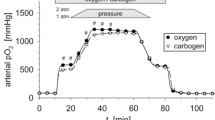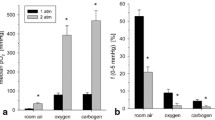Summary
The oxyhemoglobin saturation (HbO2) of single red blood cells within tumor microvessels (diameter: 3–12 µm) of DS-Carcinosarcoma was studied using a cryophotometric micromethod. In untreated control tumors (mean tissue temperature approx. 35° C) the measured values scattered over the whole saturation range from zero to 100 sat.%, the mean being 51 sat.%. Upon heating at 40° C for 30 min, the oxygenation of the tumor tissue significantly improved as compared with control conditions. After 40° C-hyperthermia a mean oxyhemoglobin saturation of 66 sat.% was obtained. In contradistinction to this, after 43° C-hyperthermia the tumor oxygenation was significantly lower and reached a mean HbO2 saturation value of 47 sat.%. A further temperature rise to 45° C caused the oxygenation to drop drastically (mean oxyhemoglobin saturation value: 24 sat.%). This is due to a severe restriction of nutritive blood flow.
The changes in tumor oxygenation after hyperthermia seem to be predominantly mediated through changes in tumor blood flow, including tumor microcirculation, which showed a similar temperature dependence. Metabolic effects probably play a minor role in the oxyhemoglobin saturation distribution within tumor microvessels.
Similar content being viewed by others
References
Acker H, Luebbers DW, Heinrich R, Grunewald WA (1978) First cryophotometric measurements of the HbO2-saturation in the cat carotid body. Adv Exp Med Biol 94: 63–67
Bicher HI, Vaupel P (1980) Physiological mechanisms of localized microwave hyperthermia. In: Arcangeli G, Mauro M (eds) Proc. 1st Meeting of the European Group of Hyperthermia in Radiation Oncology. Masson, Milano, pp 95–100
Bicher HI, Hetzel FW, Sandhu TS, Frinak S, Vaupel P, O'Hara MD, O'Brien T (1980) Effects of hyperthermia on normal and tumor microenvironment. Radiology 137: 523–580
Dickson JA (1977) The effects of hyperthermia in animal tumor systems. Rec Res Cancer Res 59:43–111
Dickson JA, Calderwood SK (1980) Temperature range and selective sensitivity of tumors to hyperthermia: A critical review. Ann NY Acad Sci 335: 180–205
Eddy HA (1980) Alterations in tumor microvasculature during hyperthermia. Radiology 137: 515–521
Emami B, Nussbaum GH, TenHaken RK, Hughes WL (1980) Physiological effects of hyperthermia: Response of capillary blood flow and structure to local tumor heating. Radiology 137: 805–809
Emami B, Nussbaum GH, Hahn N, Piro AJ, Dritschilo A, Quimby F (1981) Histopathological study on the effects of hyperthermia on microvasculature. Int J Radiat Oncol Biol Phys 7: 343–348
Endrich B, Zweifach BW, Reinhold HS, Intaglietta M (1979) Quantitative studies of microcirculatory function in malignant tissue: Influence of temperature on microvascular hemodynamics during the early growth of the BA 1112 rat sarcoma. Int J Radiat Oncol Biol Phys 5: 2021–2030
Gerweck LE, and Richards B (1981) Influence of pH on the thermal sensitivity of cultured human glioblastoma cells. Cancer Res 41: 845–849
Gerweck LE, Nygaard TG, Burlett M (1979) Response of cells to hyperthermia under acute and chronic hypoxic conditions. Cancer Res 39: 966–972
Grunewald WA, Luebbers DW (1975) Die Bestimmung der intracapillären HbO2-Sättigung mit einer kryomikrofotometrischen Methode angewandt am Myocard des Kaninchens. Pfluegers Arch 353: 255–273
Grunewald WA, Luebbers DW (1976) Kryomicrophotometry as a method for analyzing the intracapillary HbO2 saturation of organs under different O2 supply conditions. Adv Exp Med Biol 75: 55–64
Grunewald WA, Manz R (1977) Intrakapilläre HbO2-Sättigungsmessung - eine Methode zur Analyse der O2-Versorgung des Skelettmuskels unter physiologischen und pathophysiologischen Bedingungen. In: Jahnke K, Mehnert H, Reis HE (eds), Muskelstoffwechsel, körperliche Leistungsfähigkeit und Diabetes mellitus. Stuttgart, New York, Schattauer, pp 73–79
Gullino PM, Yi PN, Grantham FH (1978) Relationship between temperature and blood supply or consumption of oxygen and glucose by rat mammary carcinomas. J Natl Cancer Inst 60: 835–847
Hahn GG (1974) Metabolic aspects of the role of hyperthermia in mammalian cell inactivation and their possible relevance to cancer treatment. Cancer Res 34: 3117–3123
Holtz H, Grunewald WA, Manz R, von Restorff W, Bassenge E (1977) Intracapillary hemoglobin oxygen saturation and oxygen consumption in different layers of the left ventricular myocardium. Pfluegers Arch 370: 253–258
Johnson R (1975) Effect of hyperthermia on tumor blood flow. In: Proc. Internat. Sympos. Cancer Therapy by Hyperthermia and Radiation, American College of Radiology, Washington D.C., pp 154–155.
Luebbers DW, Wodick R (1969) The examination of multicomponent systems in biological materials by means of a rapid scanning photometer. Appl Opt 8: 1055–1062
Mueller-Klieser W, Zander R, Vaupel P (1978) Oxygen consumption of tumor cells suspended in native ascitic fluid at 1–42° C. Pfluegers Arch 377: R 17
Mueller-Klieser W, Vaupel P, Manz R, Grunewald WA (1980) Intracapillary oxyhemoglobin saturation in malignant tumours with central or peripheral blood supply. Eur J Cancer 16: 195–201
Mueller-Klieser W, Vaupel P, Manz R, Schmidseder R (1981) Intracapillary oxyhemoglobin saturation of malignant tumors in humans. Int J Radiat Oncol Biol Phys 7: 1397–1404
Otte J, Manz R, Mueller-Klieser W, Gabbert H, Vaupel P (1981) Oxygenation of DS-Sarcoma at different implantation sites. Pfluegers Arch 389: R 50
Overgaard J (1977) Effect of hyperthermia on malignant cells in vivo. Cancer 39: 2637–2646
Overgaard J (1981) Effect of hyperthermia on the hypoxic fraction in an experimental mammary carcinoma in vivo. Br J Cancer 54: 245–249
Overgaard J, Nielsen OS (1980) The role of tissue environmental factors on the kinetics and morphology of tumor cells exposed to hyperthermia. Ann NY Acad Sci 335: 254–278
Sinha AK, Neubauer JA, Lipp JA, Weiss HR (1977) Blood O2 saturation determination in frozen tissue. Microvasc Res 14: 133–144
Snedecor GW, Cochran WG (1973) Statistical Methods. The Iowa State University Press, Ames
Song CW, Rhee JG, Levitt SH (1980) Blood flow in normal tissues and tumors during hyperthermia. J Natl Cancer Inst 64: 119–124
Song CW, Kang MS, Rhee JG, Levitt SH (1980) The effect of hyperthermia on vascular function, pH, and cell survival. Radiology 137: 795–803
Suit HD (1977) Hyperthermic effects on animal tissues. Radiology 123: 483–487
Vaupel P (1977) Hypoxia in neoplastic tissue. Microvasc Res 13: 399–408
Vaupel P (1979) Oxygen supply to malignant tumors. In: Peterson HI (ed) Tumor Blood Circulation: Angiogenesis, Vascular Morphology and Blood Flow of Experimental and Human Tumors. CRC Press, West Palm Beach, pp 143–168
Vaupel P, Ostheimer K, Mueller-Klieser W (1980) Circulatory and metabolic responses of malignant tumors during localized hyperthermia. J Cancer Res Clin Oncol 98: 15–29
Vaupel P, Frinak S, Bicher HI (1981) Heterogeneous oxygen partial pressure and pH distribution in C3H mouse mammary adenocarcinoma. Cancer Res 41: 2008–2013
Vaupel P, Manz R, Mueller-Klieser W (1979) Respiratory gas exchange in the rat spleen in situ and intrasplenic oxyhemoglobin saturation. Pfluegers Arch 379: 109–111
Vaupel P, Grunewald WA, Manz R, Sowa W (1978) Intracapillary HbO2 saturation in tumor tissue of DS-Carcinosarcoma during normoxia. Adv Exp Med Biol 94: 367–375
Vaupel P, Manz R, Mueller-Klieser W, Grunewald WA (1979) Intracapillary HbO2 saturation in malignant tumors during normoxia and hyperoxia. Microvasc Res 17: 181–191
Vaupel P, Frinak S, Mueller-Klieser W, Bicher HI (1982) Impact of localized hyperthermia on the cellular microenvironment in solid tumors. Natl Cancer Inst Monogr 60: in press
von Ardenne M, Lippmann HG, Reitnauer PG, Justus J (1979) Histological proof for selective stop of microcirculation in tumor tissue at pH 6.1 and 41° C. Naturwissenschaften 66: 59
Author information
Authors and Affiliations
Rights and permissions
About this article
Cite this article
Vaupel, P.W., Otte, J. & Manz, R. Oxygenation of malignant tumors after localized microwave hyperthermia. Radiat Environ Biophys 20, 289–300 (1982). https://doi.org/10.1007/BF01323754
Received:
Accepted:
Issue Date:
DOI: https://doi.org/10.1007/BF01323754




